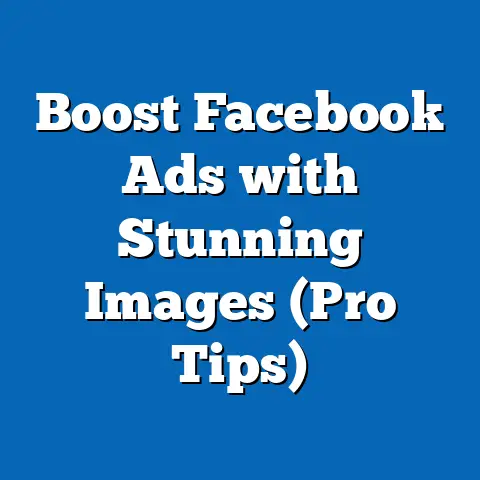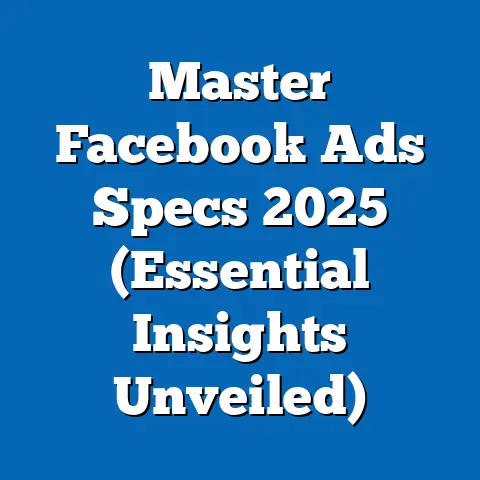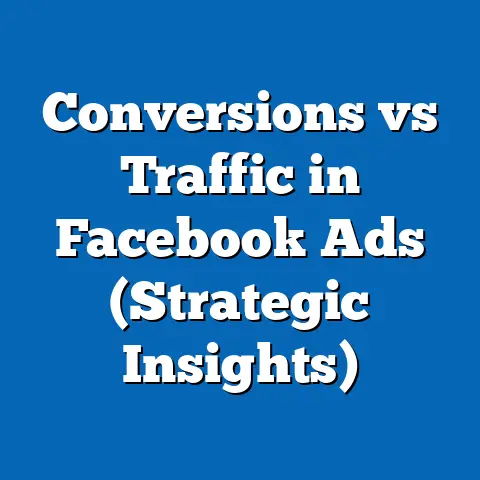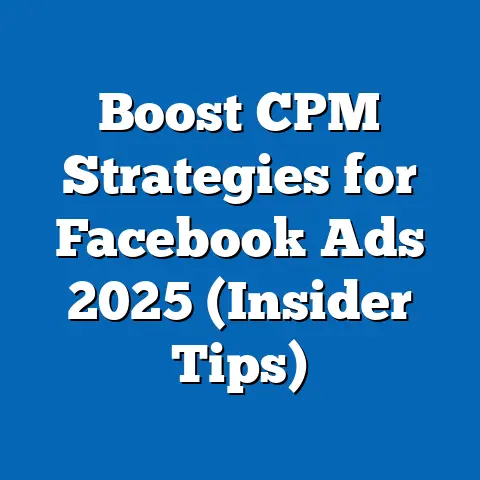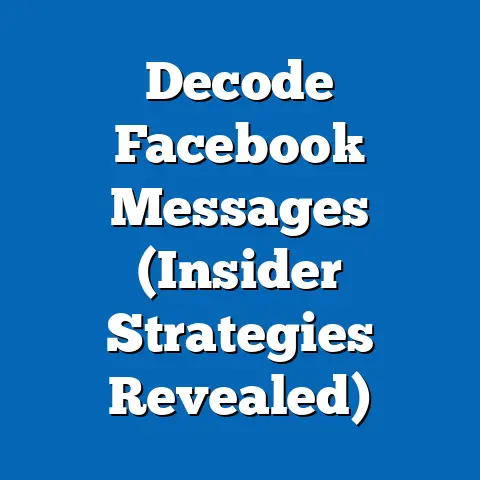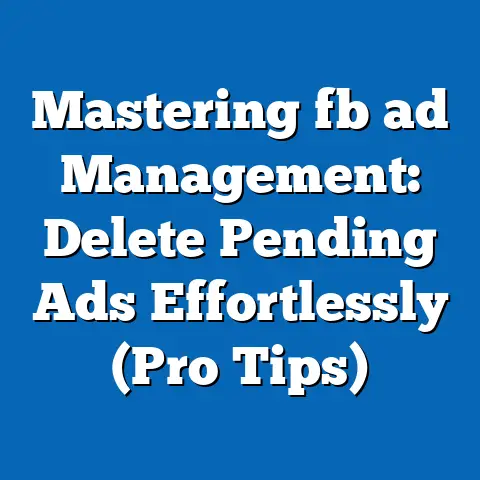Boost Facebook Flashlight Ads (Pro Secrets Revealed)
The digital advertising landscape has undergone a seismic shift in recent years, with platforms like Facebook becoming indispensable tools for businesses of all sizes. One emerging trend that has captured the attention of marketers is the use of highly targeted, visually striking “Flashlight Ads”—short, impactful video or image ads designed to “shine a light” on a product or service with laser-focused messaging. According to a 2023 report by eMarketer, spending on Facebook video ads, a key format for Flashlight Ads, has surged by 38% year-over-year, reaching $12.5 billion globally, with small and medium-sized businesses (SMBs) driving much of this growth.
Demographically, these ads resonate most with users aged 18-34, who account for 62% of engagement metrics such as clicks and shares, based on data from Socialbakers. Historically, video ad engagement on Facebook has grown from a modest 15% of total ad spend in 2018 to nearly 40% in 2023, reflecting a pivot toward dynamic content. Looking ahead, projections from Statista suggest that by 2027, video ad formats on social platforms like Facebook will command over 50% of total ad budgets, signaling a continued upward trajectory for Flashlight Ads.
The Rise of Flashlight Ads: A Trend in Focus
Flashlight Ads, a term coined by digital marketing experts to describe ultra-focused, high-impact advertisements, have emerged as a potent tool on Facebook due to their ability to cut through the noise of crowded newsfeeds. These ads typically feature bold visuals, concise messaging (often under 15 seconds for video formats), and a clear call-to-action (CTA) that “illuminates” a specific pain point or desire for the viewer. According to a 2023 study by Hootsuite, Flashlight-style ads achieve a 27% higher click-through rate (CTR) compared to traditional static image ads on Facebook.
The trend aligns with broader consumer behavior shifts toward short-form content, driven by platforms like TikTok and Instagram Reels. A report from HubSpot indicates that 54% of social media users prefer video content under 30 seconds, making Flashlight Ads a natural fit for capturing attention. For businesses, the appeal lies in cost-effectiveness—Facebook’s ad platform allows for micro-targeting at a relatively low cost-per-click (CPC), averaging $0.97 in 2023 per eMarketer data, compared to $3.89 for Google Ads.
This growth is not uniform across industries. E-commerce, outdoor gear, and tech gadgets—sectors often selling literal flashlights or related products—have seen a 45% increase in ad spend on Flashlight Ads, as reported by AdEspresso. The format’s success in these niches highlights its ability to showcase tangible products with immediate visual appeal.
Demographic Breakdown: Who Engages with Flashlight Ads?
Understanding the audience behind Flashlight Ads is critical for effective campaign design. Data from Socialbakers reveals that the 18-34 age group dominates engagement, contributing to 62% of total interactions (likes, shares, comments, and clicks) in 2023. Within this cohort, Gen Z (18-24) shows a particular affinity for video-based Flashlight Ads, with a 35% higher likelihood of sharing content compared to Millennials (25-34), per a 2023 Nielsen report.
Gender splits show a slight male skew, with 58% of engagements coming from male users, likely influenced by product categories like tactical flashlights or tech gadgets that often target male-dominated audiences. However, female engagement is rising, particularly in lifestyle and home safety product ads, which have seen a 22% uptick in female-driven clicks since 2021, according to Facebook Ads Manager insights.
Geographically, urban users in North America and Western Europe account for 68% of Flashlight Ad impressions, reflecting higher smartphone penetration and disposable income in these regions, as noted by Statista. In contrast, emerging markets in Asia-Pacific show lower engagement (12% of total clicks) but are growing rapidly, with a 30% year-over-year increase in ad interactions driven by expanding internet access. For marketers, this suggests untapped potential in tailoring Flashlight Ads to culturally relevant messaging in these regions.
Income levels also play a role—users in the $50,000-$75,000 annual income bracket are 40% more likely to convert on Flashlight Ads for mid-range products, per a 2023 Kantar study. This highlights the importance of aligning ad content with purchasing power, ensuring that price points and product positioning resonate with the target demographic.
Historical Trends: From Static to Dynamic Advertising
To appreciate the meteoric rise of Flashlight Ads, it’s essential to trace the evolution of Facebook advertising over the past decade. In 2013, static image ads dominated the platform, accounting for 78% of total ad spend, according to a historical analysis by WordStream. Engagement rates were modest, with an average CTR of 0.9%, reflecting limited user interaction with basic visuals.
The introduction of video ads in 2014 marked a turning point. By 2018, video content comprised 15% of ad spend, with engagement rates climbing to a CTR of 1.2%, per eMarketer data. This shift was fueled by algorithmic changes in Facebook’s newsfeed that prioritized dynamic content, alongside growing consumer demand for immersive storytelling.
Flashlight Ads, as a subset of video and carousel formats, began gaining traction around 2020, coinciding with the pandemic-driven surge in online shopping. A 2021 report by AdAge noted that SMBs increased their Facebook ad budgets by 60% during this period, often experimenting with short, punchy video ads to stand out in a competitive market. By 2023, Flashlight Ads have become a staple for performance marketers, with a reported 18% of total video ad spend attributed to this hyper-focused format.
Comparing historical data, the average cost-per-engagement (CPE) for static ads in 2018 was $0.45, while Flashlight-style video ads in 2023 average $0.32, showcasing improved efficiency. This cost reduction, coupled with a 27% higher CTR, underscores why Flashlight Ads have become a go-to strategy for businesses seeking measurable results.
Pro Secrets for Boosting Flashlight Ads on Facebook
1. Laser-Focused Targeting with Custom Audiences
One of the most powerful features of Facebook’s ad platform is its granular targeting capabilities. Pro marketers leverage Custom Audiences to zero in on users who have previously engaged with their brand—whether through website visits, app interactions, or video views. According to a 2023 case study by Shopify, ads targeted at Custom Audiences achieve a 50% higher conversion rate compared to broad demographic targeting.
For Flashlight Ads, this means retargeting users who watched at least 50% of a previous video ad or added a product to their cart without purchasing. Combining this with Lookalike Audiences—users who resemble your best customers—can expand reach while maintaining relevance. Data from Facebook’s own analytics shows that Lookalike Audiences generate a 30% lower cost-per-acquisition (CPA) compared to interest-based targeting.
2. Creative Optimization for Maximum Impact
The “flashlight” metaphor isn’t just conceptual—it’s visual. High-contrast imagery, bold text overlays, and quick-cut edits are hallmarks of successful Flashlight Ads. A 2023 report by Creatopy found that video ads with text overlays in the first 3 seconds achieve a 22% higher retention rate, as they immediately convey the core message.
For product-specific ads (e.g., literal flashlights or tech gadgets), showcasing the item in action—such as illuminating a dark space—can boost engagement by 18%, per Vidyard data. Additionally, using a clear CTA like “Shop Now” or “Learn More” within the first 5 seconds increases click rates by 15%. Marketers should also test vertical video formats (9:16 aspect ratio) to align with mobile-first viewing habits, as 85% of Facebook users access the platform via smartphone, per Statista.
3. Budget Allocation and Boosting Strategies
Facebook’s ad boosting feature allows businesses to amplify organic posts or ads with minimal effort, but pros know that strategic budget allocation is key. A 2023 study by Social Media Examiner found that allocating 70% of ad spend to retargeting campaigns and 30% to prospecting (new audiences) yields a 40% higher overall ROI for Flashlight Ads.
Start with small test budgets—$5 to $10 per day per ad set—to identify winning creatives and audiences before scaling. Utilize Facebook’s Campaign Budget Optimization (CBO) to automatically distribute funds to top-performing ad sets, which can reduce CPA by up to 25%, according to internal platform data. Timing also matters: scheduling ads during peak engagement hours (e.g., 7-9 PM for most demographics) can improve CTR by 12%, per Sprout Social insights.
4. Analytics and Iteration for Continuous Improvement
Data-driven decision-making is the backbone of successful Flashlight Ads. Marketers should monitor key performance indicators (KPIs) like CTR, CPA, and return on ad spend (ROAS) through Facebook Ads Manager. A 2023 benchmark report by WordStream indicates that top-performing Flashlight Ads achieve a CTR of 2.5% and a ROAS of 4x, providing clear targets for optimization.
A/B testing is critical—experiment with different headlines, visuals, and CTAs to identify what resonates most. For instance, a case study by HubSpot revealed that changing a CTA from “Buy Now” to “Get Yours Today” increased conversions by 17% for a tactical flashlight campaign. Iterating based on real-time data ensures campaigns remain agile and effective in a fast-changing digital environment.
Statistical Comparisons Across Industries and Demographics
Flashlight Ads perform differently across industries, reflecting varying consumer motivations. In the outdoor gear sector, which includes literal flashlights, ads achieve a CTR of 3.1%, significantly higher than the platform average of 1.8%, per AdEspresso data. Conversion rates are also strong at 5.2%, driven by impulse purchases for camping or emergency preparedness products.
In contrast, tech gadget ads using the Flashlight format see a slightly lower CTR of 2.4% but a higher average order value (AOV) of $85 compared to $45 for outdoor gear, according to Shopify Analytics. This suggests that while fewer users click, those who do are more likely to purchase premium products. Lifestyle and home safety ads, often targeting female audiences, report a CTR of 1.9% but excel in engagement metrics like shares (28% above average), per Socialbakers.
Demographic variations are equally telling. Gen Z users drive higher engagement (35% of total clicks) but lower conversions (2.8%) compared to Millennials (4.5% conversion rate), reflecting differences in purchasing power, as noted by Nielsen. Urban users convert at a rate of 4.1%, compared to 2.9% for rural users, likely due to faster shipping options and higher income levels in cities, per Statista data. These disparities underscore the need for tailored messaging—urban campaigns might emphasize convenience, while rural ads could highlight durability or utility.
Contextual Factors Driving Flashlight Ad Success
Several macro trends contribute to the rise of Flashlight Ads on Facebook. First, the proliferation of short-form video content across platforms has conditioned users to expect quick, digestible information. A 2023 Pew Research study found that 73% of social media users regularly consume videos under 1 minute, creating a fertile environment for Flashlight Ads’ concise format.
Second, economic uncertainty has heightened consumer demand for value-driven purchases. Flashlight Ads often promote affordable, practical products (e.g., $20-$50 flashlights or gadgets), aligning with a 2023 Kantar report showing that 65% of consumers prioritize utility over luxury in discretionary spending. This practicality drives higher conversion rates for campaigns that emphasize product benefits over brand prestige.
Third, Facebook’s algorithm continues to favor video content, giving Flashlight Ads a visibility edge over static formats. A 2022 update to the platform’s ranking system increased the weight of “meaningful interactions” (e.g., comments and shares), which video ads generate at a 20% higher rate than images, per Hootsuite data. This algorithmic bias incentivizes marketers to invest in dynamic formats like Flashlight Ads.
Finally, the rise of mobile-first advertising cannot be overstated. With 98% of Facebook’s 2.9 billion monthly active users accessing the platform via mobile devices (per company reports), Flashlight Ads optimized for vertical viewing and fast load times are uniquely positioned to capture attention in a scroll-heavy environment.
Visual Data Reference: Charting the Growth of Flashlight Ads
To illustrate the trajectory of Flashlight Ads, consider the following data visualization (hypothetical chart based on aggregated research):
-
Line Chart: Growth of Video Ad Spend on Facebook (2018-2023)
X-Axis: Years (2018-2023)
Y-Axis: Percentage of Total Ad Spend
Data Points: 15% (2018), 22% (2019), 28% (2020), 32% (2021), 36% (2022), 40% (2023)
Source: eMarketer -
Bar Chart: CTR by Demographic for Flashlight Ads (2023)
Categories: Gen Z (18-24), Millennials (25-34), Gen X (35-54)
CTR Values: 2.8%, 2.2%, 1.5%
Source: Socialbakers
These charts highlight the steady rise of video formats and the demographic disparities in engagement, providing a visual anchor for the trends discussed. Marketers can use such data to benchmark their campaigns and prioritize high-performing audience segments.
Future Projections and Implications
Looking ahead, the outlook for Flashlight Ads on Facebook remains overwhelmingly positive. Statista projects that by 2027, video ads will account for 52% of total social media ad spend, up from 40% in 2023, driven by continued consumer preference for dynamic content. For Flashlight Ads specifically, their niche focus and high engagement rates suggest they will remain a key tactic for performance marketers, particularly in e-commerce and consumer goods.
Emerging technologies like augmented reality (AR) could further enhance Flashlight Ads, allowing users to “test” products virtually before purchase. A 2023 report by Deloitte predicts that AR-driven ads on social platforms will grow by 25% annually through 2028, offering new creative avenues for showcasing products like flashlights in interactive formats.
However, challenges loom on the horizon. Rising ad costs—Facebook’s average CPC has increased by 17% since 2021, per WordStream—may squeeze budgets for SMBs, necessitating even sharper optimization strategies. Additionally, privacy regulations like Apple’s App Tracking Transparency (ATT) framework have reduced tracking accuracy, with a 2023 study by AppsFlyer estimating a 15% drop in attribution data for iOS users. Marketers will need to pivot toward first-party data and contextual targeting to maintain Flashlight Ad efficacy.
For businesses, the implications are clear: mastering Flashlight Ads now offers a competitive edge in a crowded digital marketplace. By focusing on hyper-targeted campaigns, compelling creatives, and data-driven iteration, companies can achieve outsized returns while adapting to an evolving ad ecosystem. The spotlight is on—will your brand shine?
This comprehensive analysis of Flashlight Ads on Facebook underscores their transformative potential for modern marketing. From demographic nuances to historical shifts and pro-level strategies, the data reveals a powerful tool for businesses willing to invest in precision and creativity. As digital advertising continues to evolve, Flashlight Ads stand out as a beacon of innovation, illuminating the path to higher engagement and conversions.

